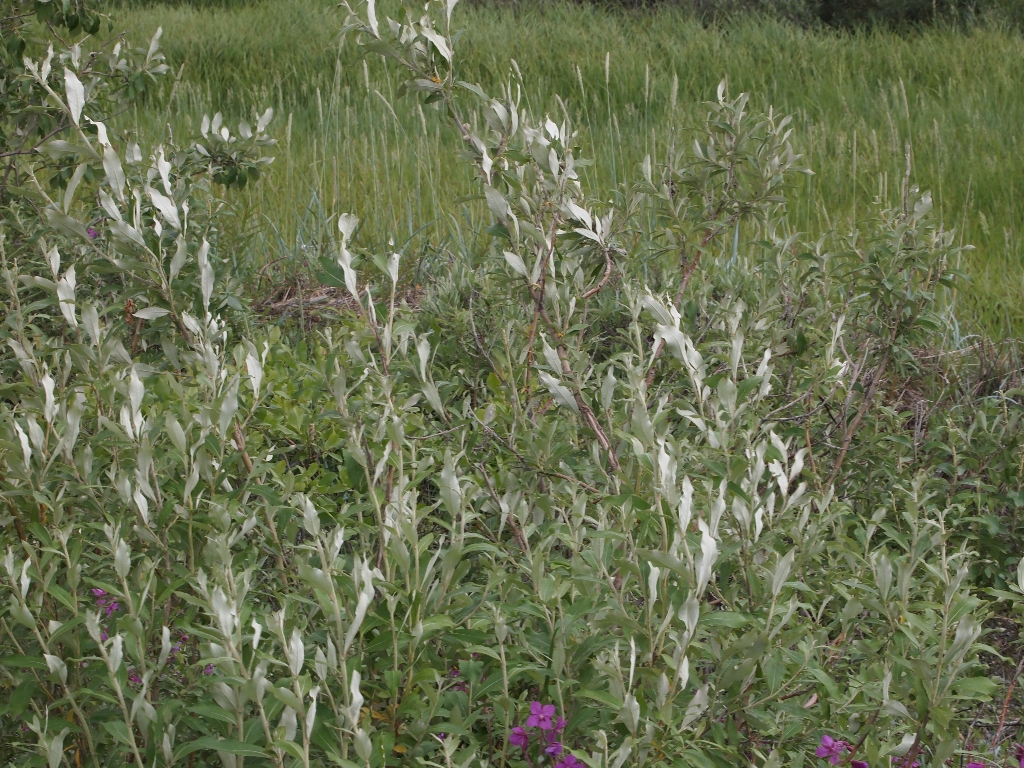
Feltleaf Willows (Salix alaxensis) are also called Uqpik (regional dialect: -piik, -piich) or Uqpisugruk in the Iñupiaq language. A favorite plant of many animals, including moose, the feltleaf willow can be found in boreal forests or along side water in the tundra.
The willow family has many successful members in the greater tundra area. The most easily recognizable of them, however, is the feltleaf. Feltleaf willow come in all shapes and sizes and can be anywhere from one to 20 feet tall. Although smooth to start, the stems and the leaves gain a nice fuzzy appearance as they mature.
The young, tender shoots can be eaten once the bark is removed. Many compare the taste to cucumbers at this stage. As the shoots age, their flavor becomes woodier, making them less sought after.
Like most willows, the Feltleaf has long been used for medicinal purposes. The bark of the willows contain salicin, an active ingredient that is compared to aspirin. It has been known to help with mouth sores, headaches, colds, fevers, and bee stings. Some will draw medicinal benefits from this plant by simply stripping the bark off and placing it directly in their mouth to be chewed. Others brew the bark into a tea. It is believed that animals will seek out willows to help ease their pains as well.
Sources:
The willow family has many successful members in the greater tundra area. The most easily recognizable of them, however, is the feltleaf. Feltleaf willow come in all shapes and sizes and can be anywhere from one to 20 feet tall. Although smooth to start, the stems and the leaves gain a nice fuzzy appearance as they mature.
The young, tender shoots can be eaten once the bark is removed. Many compare the taste to cucumbers at this stage. As the shoots age, their flavor becomes woodier, making them less sought after.
Like most willows, the Feltleaf has long been used for medicinal purposes. The bark of the willows contain salicin, an active ingredient that is compared to aspirin. It has been known to help with mouth sores, headaches, colds, fevers, and bee stings. Some will draw medicinal benefits from this plant by simply stripping the bark off and placing it directly in their mouth to be chewed. Others brew the bark into a tea. It is believed that animals will seek out willows to help ease their pains as well.
Sources:
- Jones, Anore. Plants That We Eat: Nauriat Nigiñaqtuat. Univ. of Alaska Press, 2010.
- Garibaldi, Ann. Medicinal Flora of the Alaska Natives: a Compilation of Knowledge... Alaska Natural Heritage Program, Environment and Natural Resources Institute, University of Alaska Anchorage, 1999.
- Schofield, Janice J. Discovering Wild Plants: Alaska, Western Canada, the Northwest. Alaska Northwest Books, 1995.
Is there something we missed for this itinerary?
Itineraries across USA

Acadia

Arches National Park

Badlands

Big Bend

Biscayne

Black Canyon Of The Gunnison

Bryce Canyon

Canyonlands

Capitol Reef

Carlsbad Caverns

Channel Islands

Congaree

Crater Lake

Cuyahoga Valley

Death Valley

Dry Tortugas

Everglades

Gateway Arch

Glacier

Grand Canyon

Grand Teton

Great Basin

Great Smoky Mountains

Guadalupe Mountains

Haleakalā

Hawaiʻi Volcanoes

Hot Springs

Indiana Dunes

Isle Royale

Joshua Tree

Kenai Fjords

Kobuk Valley

Lassen Volcanic

Mammoth Cave

Mesa Verde

Mount Rainier

North Cascades

Olympic

Petrified Forest

Pinnacles

Rocky Mountain

Saguaro

Shenandoah

Theodore Roosevelt

Virgin Islands

Voyageurs

White Sands

Wind Cave

Yellowstone

Yosemite

Zion